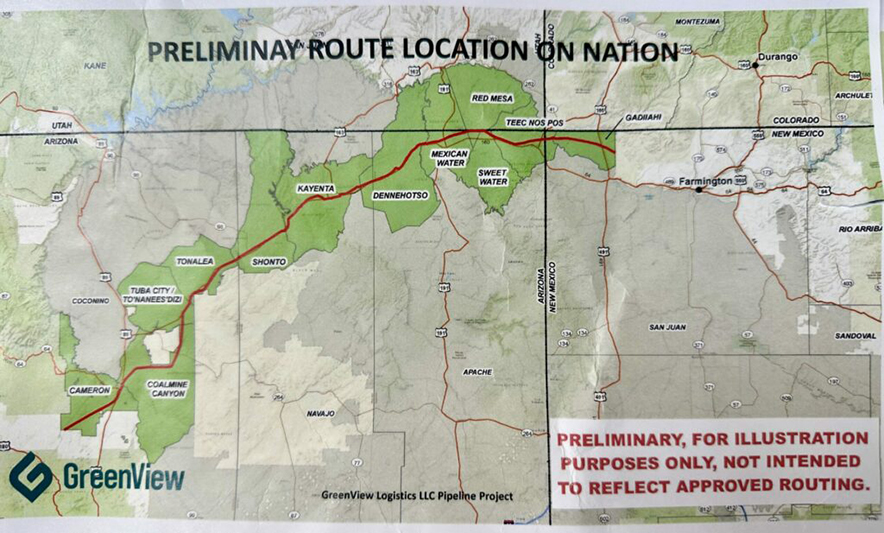
Benefits of hydrogen pipeline on Navajo Nation marketed during Northern Navajo Fair

Courtesy | Jessica Keetso
Tallgrass Energy/GreenView shows a map during a meeting in the Navajo Nation. The preliminary route follows an existing natural gas pipeline owned by the Nation, starting from Shiprock to an area north of Flagstaff.
SHIPROCK – A hydrogen pipeline could snake through northern and western Navajo.
During the 110th Northern Navajo Nation Fair, GreenView, a subsidiary of Tall Grass Energy based in the western suburbs of Denver and Lakewood, Colorado, splashed around money and sponsored the free barbecue for the fair to gain support for a hydrogen pipeline that would run through 13 northern and western Navajo chapters.
The GreenView hydrogen project is allegedly a green energy initiative being marketed as the answer to the energy crisis and the cessation of annual funding to Navajo Nation coffers from the closures of coal-fired power plants at Navajo Generating Station and the Four Corners Power Plant.
Adam Shiche, vice president of GreenView, said the company is looking to potentially partner with the Navajo Nation on the project that will traverse about 200 miles of the Navajo Nation through 13 chapters: Mexican Water, Gadíí’áhí, Hogback, Red Mesa, Dennehotso, Tółikan, Kayenta, T’iis Názbąs, Coalmine Canyon, Tuba City, Tonalea-Red Lake, Shonto, and Cameron.
Uses for hydrogen energy
“We would have hydrogen production somewhere in the Four Corners region here, and pipeline across the Navajo Nation, and then ultimately, the pipeline will grow to meet (the) demand for hydrogen in the Southwest, primarily, domestically, here in the Southwest of the United States,” Shiche said.
There are several different uses for hydrogen, according to Shiche, commenting that the evolving markets for hydrogen include transportation. He cited semi-trucks operating on hydrogen fuel cells and large ships crossing the ocean powered by hydrogen or ammonia as fuel as primary examples of the benefits of hydrogen energy.
Shiche added that hydrogen can be used for power production by burning hydrogen to produce energy for the “emerging economy” that expects more uses as the industry develops.
However, this effort will require water, a resource that the Navajo Nation cannot afford to squander in the shadow of previous energy-producing operations on tribal homelands.
“When you do that, all you have is water vapor when you burn hydrogen, so it’s a really great clean fuel for that,” Shiche said, adding that Tall Grass Energy has been in operation for many years and owns and operates about 10,000 miles of energy infrastructure across the country.
“We’re here to earn the trust and respect of the Navajo Nation, and we really look forward to collaborating with the Navajo Nation on what I really think is a transformational clean energy project,” Shiche said.
His colleague, the head of marketing efforts for the GreenView project, expressed similar sentiments.
Rachel Carmichael, the senior director of public affairs for GreenView, said they have visited 13 chapters across the Navajo Nation to “help them understand what we want to do with the hydrogen project.”
She said the company is working chapter by chapter to gain feedback and understand the chapter needs “to give equity to the Nation.”
“We’re not just doing one-time payments for just laying a normal pipeline project. We’re asking for partnership with the Nation,” Carmichael said. “This is about growing equity over many years.”
Read the full story in the Oct.12 edition of the Navajo Times.








 Highway 264,
Highway 264, I-40, WB @ Winslow
I-40, WB @ Winslow